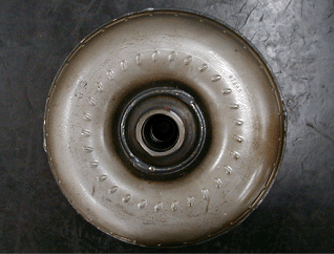

The TCM controls the locking and unlocking of the Torque Converter Clutch ( or Damper Clutch ), to the input shaft of the transmission, by appling hydraulic pressure. The main purpose of T/C clutch control is to save fuel by decreasing the hydraulic load inside the T/C. The TCM outputs duty pulses to control the Damper Clutch Control Solenoid Valve( DCCSV ) and hydraulic pressure is applied to DC according to the DCC duty ratio value. When the duty ratio is high, high pressure is applied and the Damper Clutch is locked. The normal operating range of the Damper Clutch Control duty ratio value is from 30%(unlocked) to 85%(locked).
The TCM increases duty ratio, to engage the Damper Clutch, by monitoring slip rpms. (difference in value between engine speed and turbine speed ). However, If a very small amount of slip rpm is maintained, the TCM applies 0% duty ratio value, then the TCM judges that the Torque Converter Clutch is stuck ON and sets this code.
Item | Detecting Condition & Limp Home | Possible Cause |
DTC Strategy | ● Rationality-high | ● DCC or oil pressure system faulty. ● DCCSV faulty. |
Enable Conditions | ● PCM(E/TCM) release damper clutch ● 50℃<oil temp.< 130℃ ● Throttle position >20%, ● Output speed>1000rpm ● Engine RPM>0 rpm, ● Inhibitor SW≠P,R,N-range ● No Inhibitor SW and Input speed faulty | |
Threshold Value | ● Calculated slip (engine speed-input speed)< 100rpm | |
Diagnostic Time | ● More than 7sec | |
Fail Safe | ● Damper Clutch does not operate. |